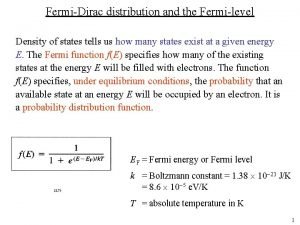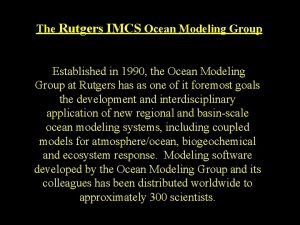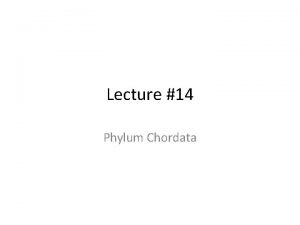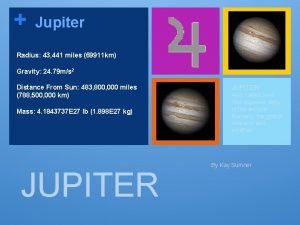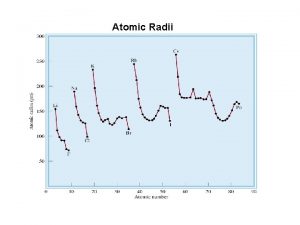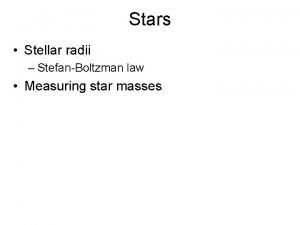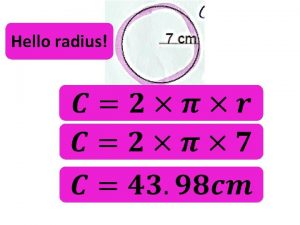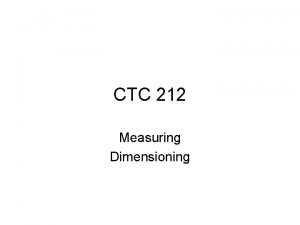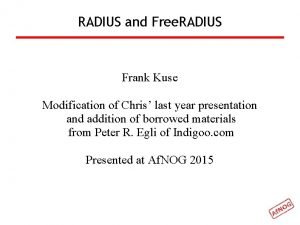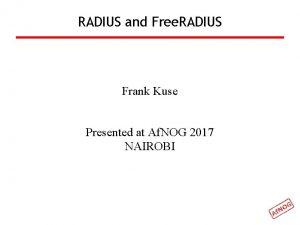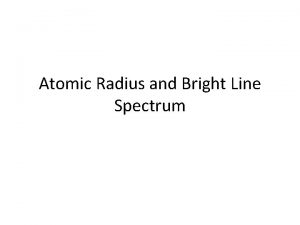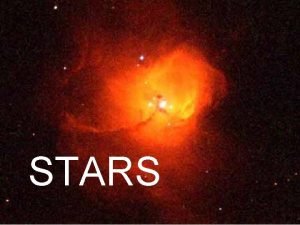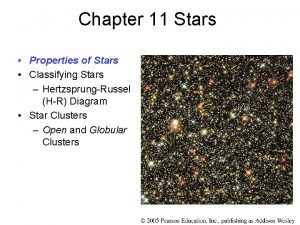Measuring Radii and Temperatures of Stars R radius


















- Slides: 18

Measuring Radii and Temperatures of Stars R = radius r = distance R/r=angular diameter • • Definitions (again…) Direct measurement of radii • Photometric determinations of radii • Determining temperatures – Speckle – Interferometry – Occultations – Eclipsing binaries – Bolometric flux – Surface brightness – Absolute flux – Model photospheres – Colors – Balmer jump – Hydrogen lines – Metal lines

Stellar Diameters • Angular diameters typically measured in milliarcseconds (mas) • Angular diameter (in radians) given by physical diameter divided by distance The diameter of Aldebaran is ~40 RSUN. Its distance is about 19 pc. The angular diameter of Aldebaran is … (work in cgs or MKS units or work in AU and use the definition of a parsec) What would the angular diameter of the Sun be at 10 pc?

Speckle Diameters • The diffraction limit of 4 -m class telescopes is ~20 mas at 4000 A, comparable to the diameter of a few stars • The seeing disk of a large telescope is made up of the rapid combination of multiple, diffraction-limited images • 2 -d Fourier transform of short exposures will recover the intrinsic image diameter • But only a few stars have large enough angular diameters. • Speckle mostly used for binary separations

Interferometry • 7. 3 -m interferometer originally developed by Michelson • Measured diameters for only 7 K & M giants • Until recently, only a few dozen stars had interferometric diameters


CHARA Interferometer on Mt. Wilson

CHARA Delay Compensator


Other Methods • Occultations – Moon used as knife-edge – Diffraction pattern recorded as flux vs. time – Precision ~ 0. 5 mas – A few hundred determined • Eclipsing binaries – Photometry gives ratio of radii to semimajor axes – Velocities give semi-major axes (i=90)

Photometric Methods – Bolometric Flux • Must know bolometric flux of star – Distance – Temperature – Bolometric correction • Calibrated with – Stellar models – Nearby stars with direct measurements (R is radius in solar units, r is distance in parsecs)

Surface Brightness • To avoid uncertainties in Teff and BC • Determine PV as a function of B-V PV(B-V)=log. Teff – 0. 1 BC • PV(B-V) is known as the “surface brightness function” • Calibrate with directly measured diameters

Absolute Flux • Determine the apparent monochromatic flux at some wavelength, Fn • From a model that fits the spectral energy distribution, compute the flux at the star’s surface, Fn • From the ratio of Fn/Fn, compute the radius • The infrared flux method is just this method applied in the infrared.

Hipparcos! • The European Hipparcos satellite determined milli-arcsec parallaxes for more than 100, 000 stars. • Distances are no longer the major source of uncertainty in radius determinations for many stars • Zillions of stars within range of the Keck interferometer (3 mas at 2 m) • USNO & CHARA interferometers < 1 mas – Surface structure – Pulsations – Circumstellar material

Determining Temperatures • Recall the definition of the effective temperature • Model photospheres • Temperature calibrations – Teff vs. B-V • Slope of the Paschen continuum • Color indices – synthetic colors • Balmer Jump (in hotter stars, but also pressure sensitive) • Hydrogen lines • Metal lines and metal line ratios

Temperatures – Balmer Jump and Balmer Continuum “The determination of Teff of B, A and F main sequence stars from the continuum between 3200 A and 3600 A; ” Sokolov, N. A. ; Astronomy and Astrophysics Supplement, v. 110, p. 553

Using Line Ratios

Calibration of line depth ratios

More line ratios
 Medical terminology lesson 8
Medical terminology lesson 8 There are millions of stars in the space
There are millions of stars in the space Radius periodic table
Radius periodic table Ionization energy on periodic table
Ionization energy on periodic table Two circular discs a and b with equal radii are blackened
Two circular discs a and b with equal radii are blackened Water hardness can affect cleaning by servsafe
Water hardness can affect cleaning by servsafe Fermi dirac distribution function tells.
Fermi dirac distribution function tells. Fermi-dirac distribution function at different temperatures
Fermi-dirac distribution function at different temperatures Fermi energy formula
Fermi energy formula A biome that is cold, dry and treeless.
A biome that is cold, dry and treeless. Law of intermediate metals
Law of intermediate metals Canada heat wave temperatures
Canada heat wave temperatures Rutgers ocean temperatures
Rutgers ocean temperatures Tempering chocolate temperatures chart celsius
Tempering chocolate temperatures chart celsius Instrumenti per matjen e temperatures se ajrit
Instrumenti per matjen e temperatures se ajrit Thermoneutral
Thermoneutral Radioulnar joint
Radioulnar joint Jupiter radius in km
Jupiter radius in km Secant-tangent theorem
Secant-tangent theorem






